CRITTERS AT or NEAR BRAZOS BEND STATE
PARK--SNAKES non-venomous 5
This page was born
03/13/2023. Rickubis designed it. (such as it is.)
Last update: 03/04/2025
Images and contents on
this page copyright ©2002-2025 Richard M. Dashnau
Snakes
page 1 nonvenomous 2001 -2002 Snakes page 6 Rat Snakes 2002 - 2021
Snakes
page 2 nonvenomous 2003 -2004 Snakes page 7 venomous 2002 -2021
Snakes
page 3 nonvenomous 2004 -2006
Snakes
page 4 nonvenomous 2006 -2021
----------------------------------
That's me on a trail (03/29/2004). As I get more pictures, these
pages expand. I've gotten enough images of snakes to collect them
on the snake pages. For most of my identification, I'm using "Texas Snakes-a field
guide", by
James R. Dixon and John E. Werler (2000, 2005)
02/09/2025
Three
snakes having a bad day.
I found the first one near 40-Acre
Lake on Oct.
27, 2024. I photographed the
mangled carcass, thinking that the
details
of the skull might be useful.
One of the images clearly shows the
formidable array of very sharp teeth
that hook backwards towards the
throat. These help prevent
struggling prey from
pulling away, and also "encourage"
it to go towards the throat. Based
on the visible reddish scales, I
believe that the carcass belonged to
a Broadbanded Water Snake (Nerodia
fasciata).
Considering the condition of the
carcass, I believe that something
had spit it up. So, maybe two
bad days for that snake. Being eaten
is bad--but being barfed back up has
got be be worse.
We can compare with this image of
another Broadbanded Water Snake I
saw having a better day on April 17,
2017. The red blotches on the
underside are very prominent.



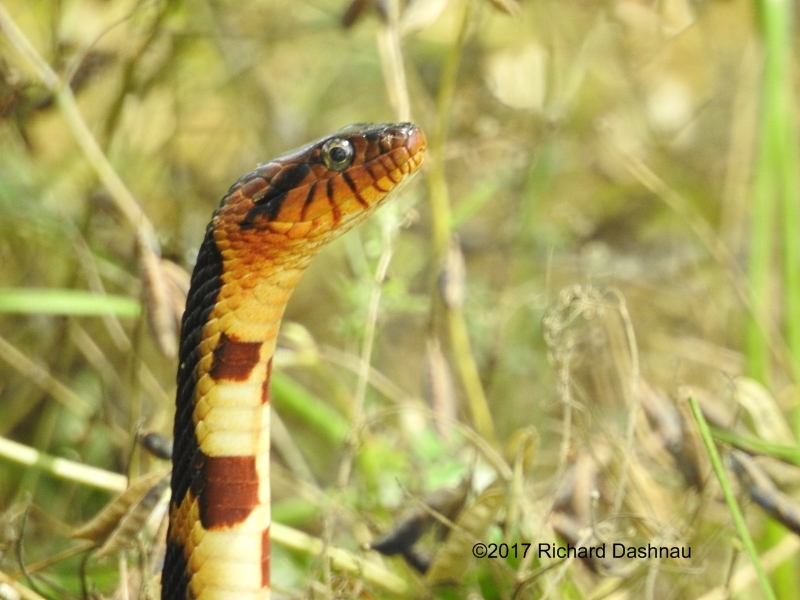
The next two were having the
same bad day- 02/09/2025.
The first snake had
been struggling for a while before I
started filming. I expected to see
it trying to swallow prey. But
it had apparently gotten its jaws
around a plant! Its
exhalations
made large bubbles as it rested.



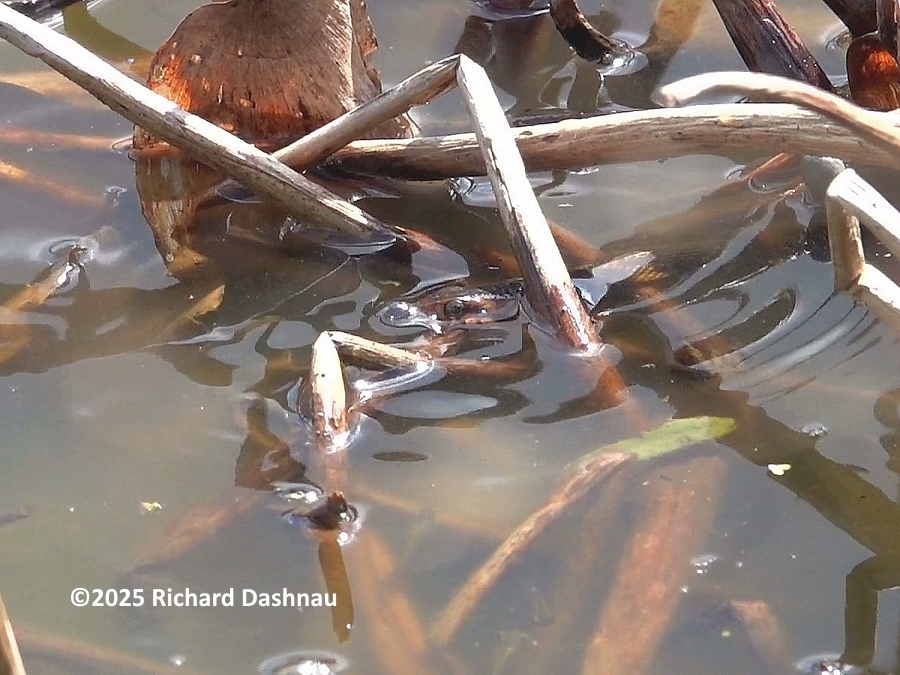
When the snake moved again, it
pulled against the stalk. I believe
its teeth were caught. The snake's
teeth were firmly fixed; but it had
had to get free.



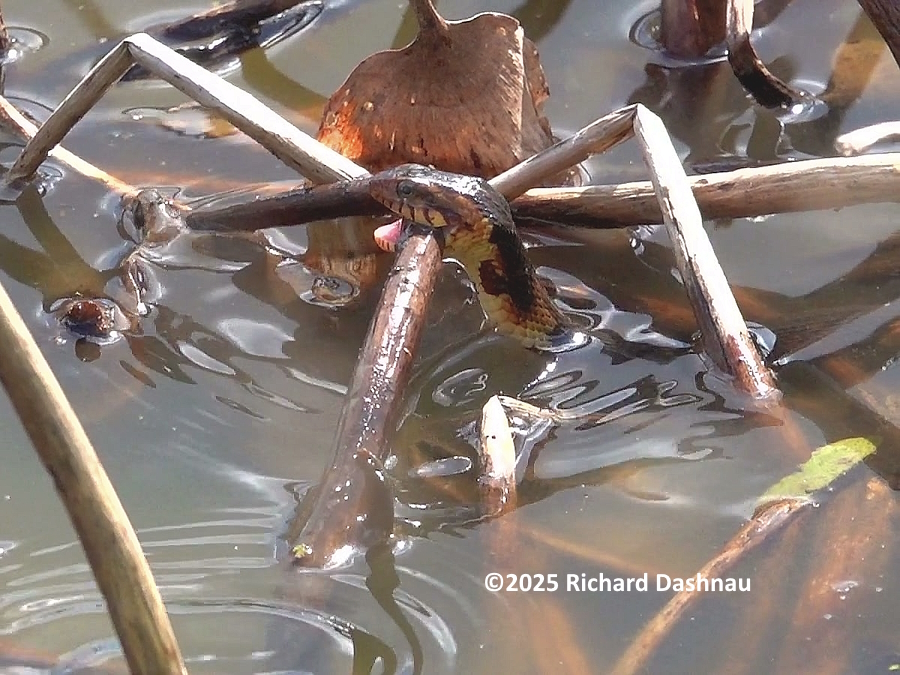
The snake re-positioned its body
for a better grip, and then gave a
really hard pull. It finally got
free! The captured video is edited
into this short film.



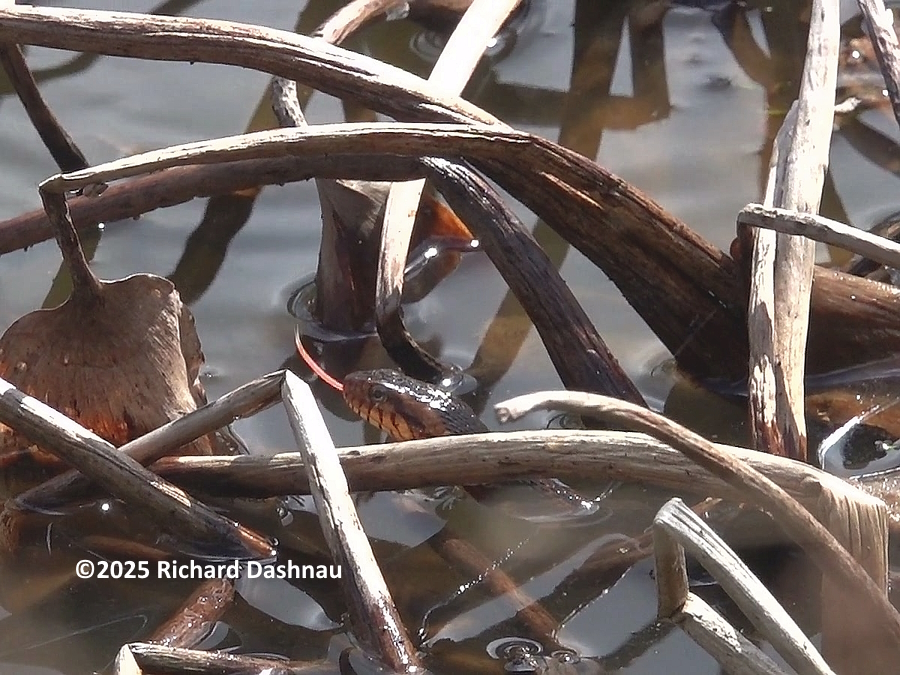
There were small fish swimming
nearby. I wonder if the snake
accidentally grabbed the stalk when
it went for one of them.To see how
this could happen, we can use the
carcass I
found on the 40-acre Lake trail in
2024 (pictured just above).
When those hooked teeth snagged in
the plant stalk, they would be
really hard to release.
The second snake
appeared about 12 minutes
later--while I was standing in the
same spot! Unfortunately, it had
been caught by a Boat-tailed Grackle
(Quiscalus major). A couple
Grackles had started hunting in the
floating plants and this one
appeared with the snake, and flew
off--just like that! I captured
photos and video, to try to identify
the snake.



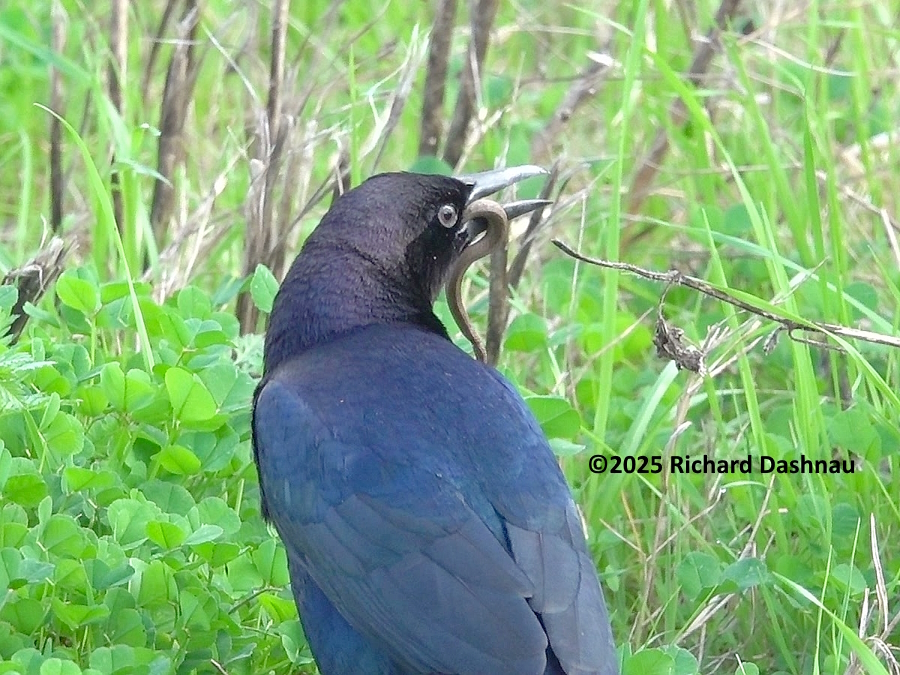
The Grackle looked at us with its
dark(not yellow) eyes. The snake's
head is relatively small, and the
snake is light brown on top. There
is a thin dark line near the
boundary between
off-white and pale brown strips. It
was possibly a young Graham's
Crayfish Snake (Regina
grahamii). We can compare this
to these photos of an adult I saw at
Fiorenza Park in 2024.
That snake seemed nearly blind, and
I moved it off the bridge. The video
of the Grackle has been edited into
this short film.




02/02/2025
Here are
some interesting events brought
about the the very warm weather
(about 70° F after noon) at Brazos
Bend State Park. The morning was
still cool as this lone
alligator cruised in 40-Acre Lake at
9:00am. While
heading back towards 40-Acre Lake
after 2:00pm, I noticed some park
visitors intently watching
something. They had found a live
snake lying on top of the
sparse vegetation, about 15 yards
from the North side of the trail. I
could tell that it was a Gulf Coast
Ribbon Snake (Thamnophis proximus),
and when I
looked through the binoculars I saw
that it was actually two
snakes! I kept watching, and
discovered I was wrong. There
weren't two snakes after all. There
were THREE snakes!
The largest snake was probably a
female, while the other two
were probably males. They were
probably mating. Or trying to. I've
seen something like this before, but
involving
Diamondback Water Snakes.(lower on
this page)
When it's time to mate, the female
snakes advertise via scent. Male
snakes are attracted by this, and
they try to get with the female. The
problems arise when multiple males
get the
same message at the same time.
I could see multiple tails hanging
down in the plant cover, and
intertwined as the males tried to
enter a single portal at the same
time. I watched for
about an hour, pointing out
the event for visitors passing
by. During that time, another
snake swam by and left the water,
but it moved off on a low branch,
apparently going in the
wrong direction. I left before the
snakes did.



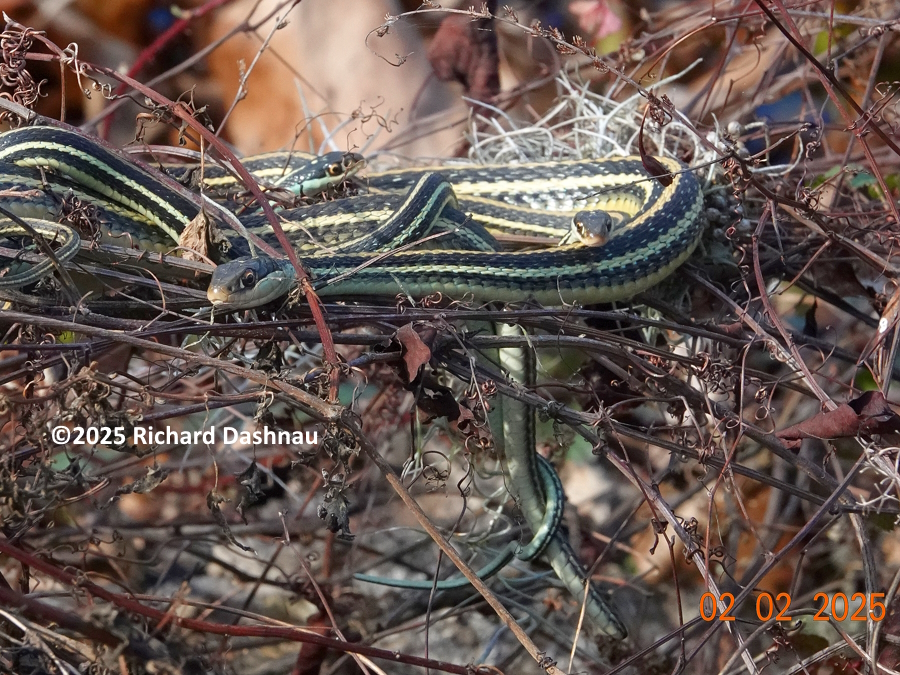
05/04/2024 At
BBSP (which was celebrating its 40-year anniversary). I happened to be
walking in the same direction as a large group of visitors,
along with a Ranger with the TPWD Outdoor Family Program. We were
just a bit West of the composting bathrooms when the TPWD went
over to a couple of visitors
in the group. It turned out that they were examining some plants. But
the TPWD asked "are you looking at the snake?" Yes, there was a
small Broadbanded Water Snake
(Nerodia fasciata) on a log, and it was eating something. The snake was
small, no more than 12 inches long. When I looked through my binoculars,
I saw legs, and shiny
skin-so I called out "it's eating a frog!" Meanwhile, the
ranger called out "It's eating a fish!" It was pretty funny, because
when I looked again, I saw a flappy tail, but no
legs. However, when I examined the pictures and video--I discovered that
it was eating a tadpole! And--the tadpole had legs. So, it had legs
*and* a flappy tail. So I wasn't
crazy after all! Well, not at that particular moment, anyway.




The
small snake quickly swallowed the large tadpole. The images below show
the tip of the tail as it went in, then a bit of jaw readjustment. I was
shooting photos here, and got to the
end of the burst before the snake had finished its "yawn". It does
look happy in the last photo. Yeah, yeah...it's just a snake. It
probably can't be "happy" like we feel happy. But I didn't
say it was happy. I said it looked happy. Away with you.




04/20/2024 At
Fiorenza Park. This Diamondback Water Snake (Nerodia rhombifer)
was in the grass near the water's edge. It was very thick, and I thought
that it might be carrying eggs. These snakes are ovovivaparous, that is,
the eggs incubate inside the female's body. They are born alive, and
ready to forage. I just assumed
that the snake was a female. I thought it might be ready to birth young
right there, but then it moved into the water. I got some very good
close pictures showing the vertical
black lines at the rear edges of each of the snake's lip scales, and the
round pupil in the eye. These, along with the general coloring and
markings, distinguish it from a Water
Moccasin (Agkistrodon piscivorus).




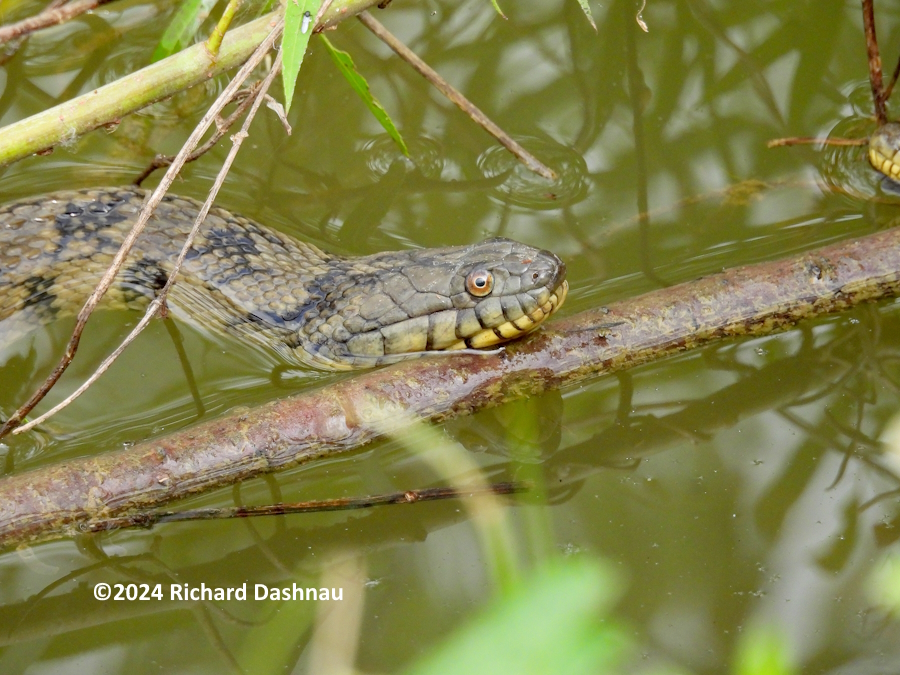
It
was possibly scared off by other people walking on the sidewalk just a
few yards away. I think I found it again, and was taking pictures of it
when a smaller snake
of the same species appeared. (new note 05/30/2024).
I've discovered that exclusively in this species, the oldeer male snakes
have small bumps (tubercles) under their chin
(Texas Snakes by Werler and Dixon (the big book) ©2000 p.217). I can see
them in the 2 cropped images below.


And
then, without many "preliminaries", the smaller snake attempted to mate
with the larger one. There is video here.




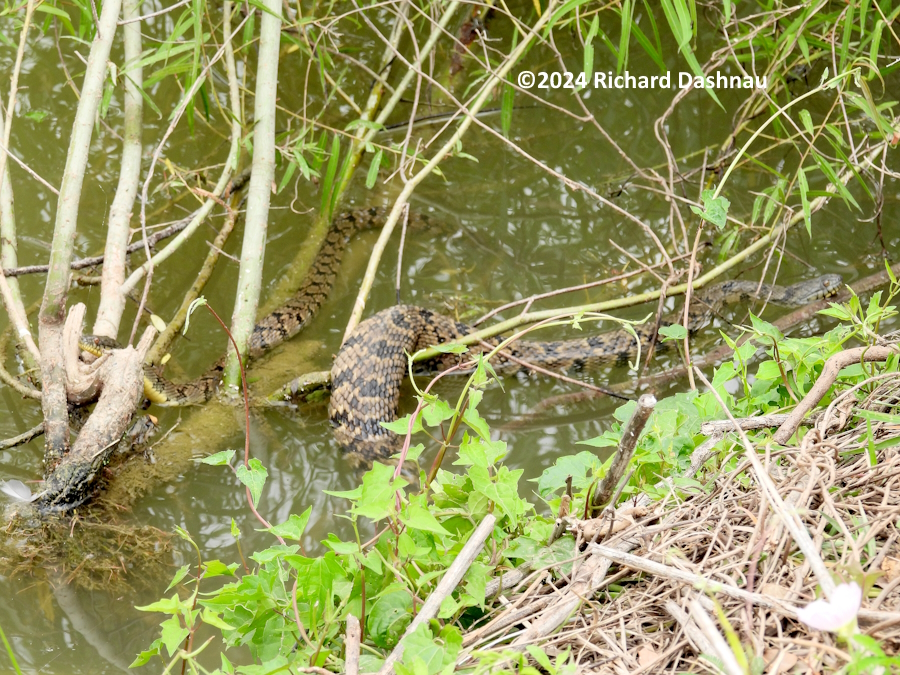
The snakes' tails twisted together,
and I assume that they were connected there. Their vents were hidden by
the contact.





This
activity ended after 20 minutes, when the male untangled his tail, and
left. Not what I expected to witness that morning; but evidence that
mating that I'd seen on
03/29/2024 was still in progress.




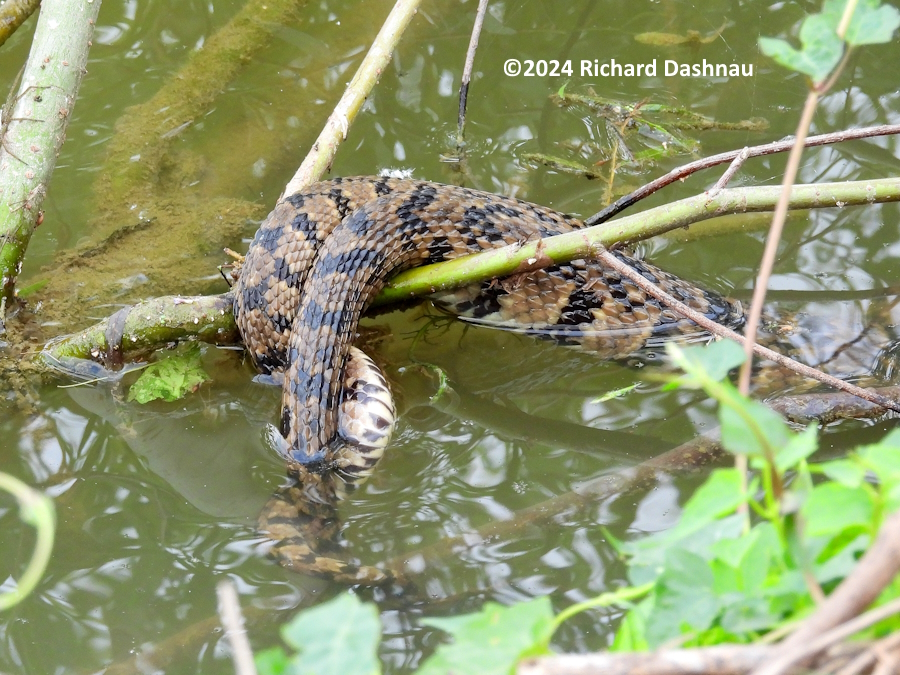
On
03/29/2024 At
Fiorenza Park, I noticed some movement on the bank across from me. When
I looked through binoculars I found that there was a small pile of
snakes
mating. I stayed where I was so I wouldn't disturb them and captured
telephoto images. They were Diamondbacked Water Snakes (Nerodia
rhombifer). I'd never directly
observed a "mating competition" before. During the mating season, the
female snakes emit pheremones which atttract the male snakes. Since the
scent carries everywhere,
it attracts males...
... from everywhere. The males apparently don't do physical dominance
displays (at least from what I could find). From my observation today,
it seems that whatever male
arrives first begins mating, and then those that come later just try to
do the same thing--which leads to a lot of "tail wrestling" as they
simultaneously try to place their
cloaca near the female's.




I was finally able
to determine that there were 3 snakes in the bundle. During the
encounter, one of the males fell off the bank and into the water. But,
another snake
(possibly the same one) climbed back onto the other two. I stopped
watching after about an hour, mostly because I didn't want to call
attention to the snakes. Not everyone
who walks the trail (concrete sidewalks) at Fiorenza Park is friendly to
snakes. The pictures don't really show how interesting this was. But I
have an edited video here.



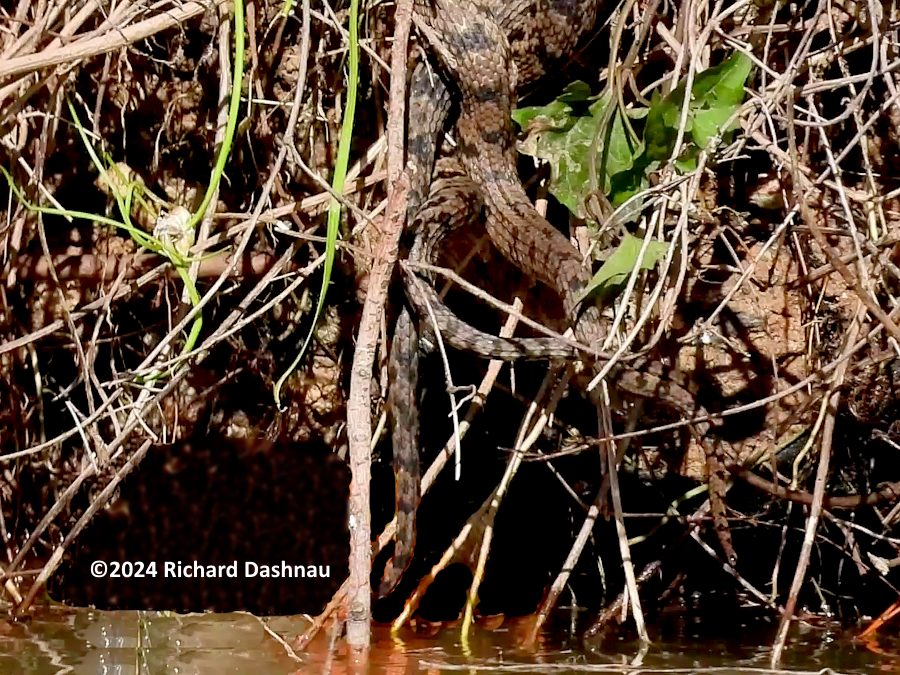
On
03/11/2023 it
was a pretty blustery day at Fiorenza Park. The water was pretty
rough from the wind, and not many birds were active; but I had some luck
anyway.
Around 10:30am, I saw this Yellow-bellied Water Snake (Nerodia
erythrogaster). It didn't move very much, probably discouraged by
the waves washing over everything,
and the intermittent sun. This snake's body was almost black with no
markings, and it had a pale yellow underside. Each lip scale had dark
lines on one edge, the the eyes
had prominent round pupils. Also, note how the bottom edge of the eye
touches the top edge of at least one of the upper lip scales. This was
definitely one of the
non-venomous water snakes, and probably a Yellow-Bellied Water Snake.



About 20 minutes later, I saw
the gray head of a Diamond-backed Water Snake (Nerodia
rhombifer) poking out of the water near some rocks. The
waves were active there as well, so the snake
just rested
for a while. I shot telephoto closeups (I didn't get closer so the
snake would stay out), and was having a good time making adjustments
with the camera. While
I was adjusting the
exposure, I
happened swing the camera up a few degrees...and I noticed golden eyes
in the darkness (darkness caused by white-balance shift in the camera).
When I looked closer, I saw two
American
Bullfrogs (Lithobates catesbeianus) hiding in the shade!



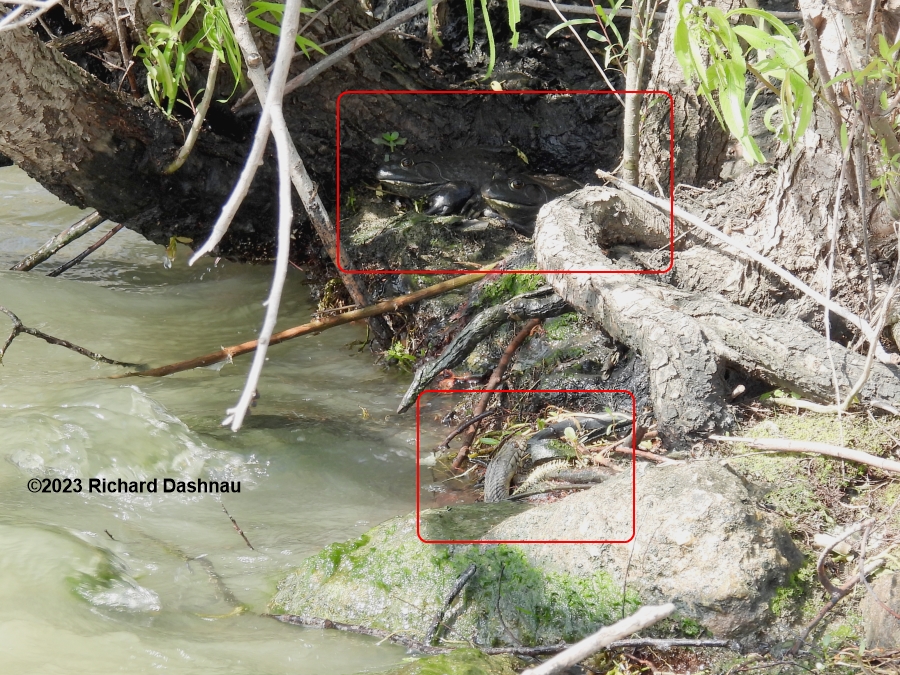
They didn't move at all--even
when the snake moved out of the water, squeezed under a
root, then poked its head over the top to look in my
direction. After being blown around for a few
minutes
more (I even had trouble
holding the camera steady), I moved off.




On 03/05/2023 I was talking with a group of
visitors near the Observation Tower, when this small snake
crawled onto the trail, almost between their feet. I
picked up the snake so it wouldn't
get stepped on, and because it was such a great
interpretive moment--especially since a few of the group
were apparently not snake fans. Using my hand for
scale, you can see how small it
was. Overall dark green on top with faint darker bands;
black background and yellow markings on belly; changing to
solid pale color under neck. Eyes with round pupils, head
oval viewed from
above,with back of head blending into neck. Scales on the
upper surface are keeled (each scale has raised ridge in
the center). There are extra scales between the bottom of
eyes and the
scales on the lips--not quite as obvious on such a small
snake (which is why I took the close images of its head).
I'm pretty sure this was a young Mississippi Green
Snake (Nerodia cyclopion).
It was very docile and easy to handle (I only handled this
one, because I work for BBSP.) I released it into
the grass on the other side of the trail.




From
Brazos Bend State Park on 01/01/2023:
Texas Parks
and Wildlife welcome the New Year by offering First Day Hike
events at various parks throughout the state. At BBSP, we were
part of the celebration. We offered various intrerpretive
tables set up around the 40-Acre Lake trail; along with
various park staff and volunteers walking that trail and
doing
"roving interpretation" (I was in that group). The even
was from 8am to 12pm, and after that I rwas walking back
towards my car (along with 2 other volunteers), on the North
side of the trail,
when a park visitor riding by on a bike told us he'd seen
a snake further up the trail. We found the snake, and while
one of the other volunteers held it and shared facts about it
to some visitors,
I took a few pictures. It was another Western Mud Snake.
The scales seemed a bit dull, so it was possibly ready
to molt soon. The snake was released further off the
trail, closer to the water.



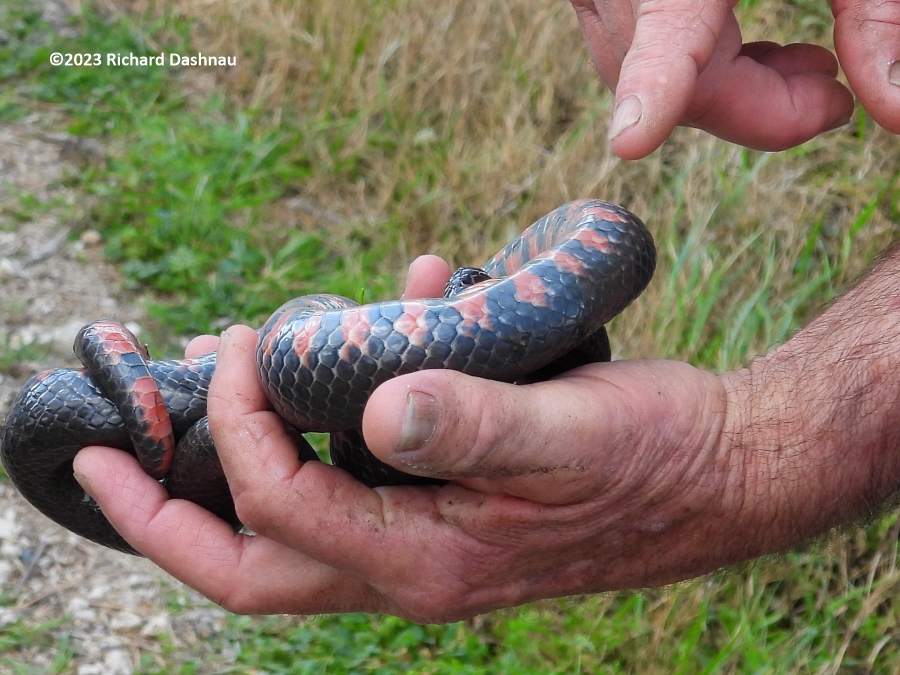
From
Brazos Bend State Park on 11/06/2022
About
11:30am, I was talking to some visitors about the baby gators
when this beautiful Western Mud Snake (Farancia abacura
reinwardti)
crawled out of Pilant Lake and crossed the trail right
next to us! I kept the visitors back so we could watch
it leisurely cross to our side. I was trying to get details,
and describing the snake
for the visitors; so I didn't get an overall picture of
it to compare with the trail width.
Mud snakes are usually nocturnal. It was probably moving
during the day because Pilant Lake was dry.
The last image below is a detail of its interesting tail. It's
hard to see, but the tip of that tail is actually a pretty
sharp point It's not barbed, but it is unnerving if the
snake probes you with it. Some
sources say that they use the tail to probe the environment
for its favorite food (amphibians, especially sirens) and
flush them out with the point. Along with the photos, I
shot video of the snake.
If you'd like to see video of this beautiful snake crossing
the trail, it
is here.




About 5 minutes later, there more drama! Great
Blue Heron that had been stalking the area (as mentioned
above...baby gators were around) stabbed into the weeds and
came up with
squirming prey colored with stripes. At first I thought it had
caught a baby gator...but then recognized it had caught a
snake. With the apparent black with white speckled colors, I
thought at
first--Speckled King Snake. That didn't make sense (I don't
think this is its favored hunting zone). I watched the events
happen, and tried capturing enough images to identify the
snake.




Some of the images are grabs from video, too. Let's try
to identify the snake. The head is not shaped like a
pit-viper's (not blunt profile, no gland swelling at the rear
of the jaws). The top
(dorsal) color is a sort of dark green. Not any bands across
the body(head shape & round pupil & no mask(stripe on
side of head) rule out Cottonmouth. No stripes along the
dorsal and sides.
So not a Ribbon Snake or Garter Snake. Could be a water snake.
No orange colors on top or bottom--so not Broadbanded Water
Snake. But look at that pattern on the belly, especially
visible starting near the tail and stopping about 4
inches behind the head. It's not a double line--so not a
Crayfish Snake. How about this: "numerous yellowish
half-moons, they cover most of
the belly, which is typically yellowish-white on the forward
third and grayish or brownish on the midbody and the rear".
--from Texas Snakes-A Field Guide by Dixon and Werler ©2000
page198.
This sounds about right to me. If it is, then this was a
Mississippi Green Water Snake (Nerodia Cyclopion) The
Heron dealt with the snake as they normally deal with large
prey. There were
multiple stabbing, picking up to sense movement, drop and stab
again cycles,; until it was time to swallow the snake. This
was a bit of a problem, because the snake had tied the rear of
its
body into a very large knot. This discourage the Heron, but
only for a little while. It did finish its meal.
Interesting times in a very small part of the park.



From
Fiorenza Park North on 08/27/2022
and 09/03/2022
While
I was at Fiorenza park on 8/27/22, I noticed a fisherman using
a cast net. I've seen others using cast
nets
there,
and I assumed that they were catching small fish (usually
shad) for live bait. But I noticed that this fisherman
was usually just dumping out his net, and discarding most of
the fish.
He threw
most back into the water, but there were always few stragglers
left on the bank. While I watched from the hill above, I
noticed a water snake swimming near him. As I watched
in
surprise, the snake moved to where the fisherman had been (and
he hadn't gone far), crawled up on the grass, snatched a fish
and slithered back into the water!
The snake
came back, but was scared away by passing bicycles. I
went down to see if the snake would try for any of the other
fish remaining near the water. The snake reappeared, and
I
stood
near the snake and the few small fish hidden in the grass. The
snake came ashore, and was definitely on the hunt.
Unfortunately, it returned to the water when some other people
came by. I did get some video which I've edited into this file.




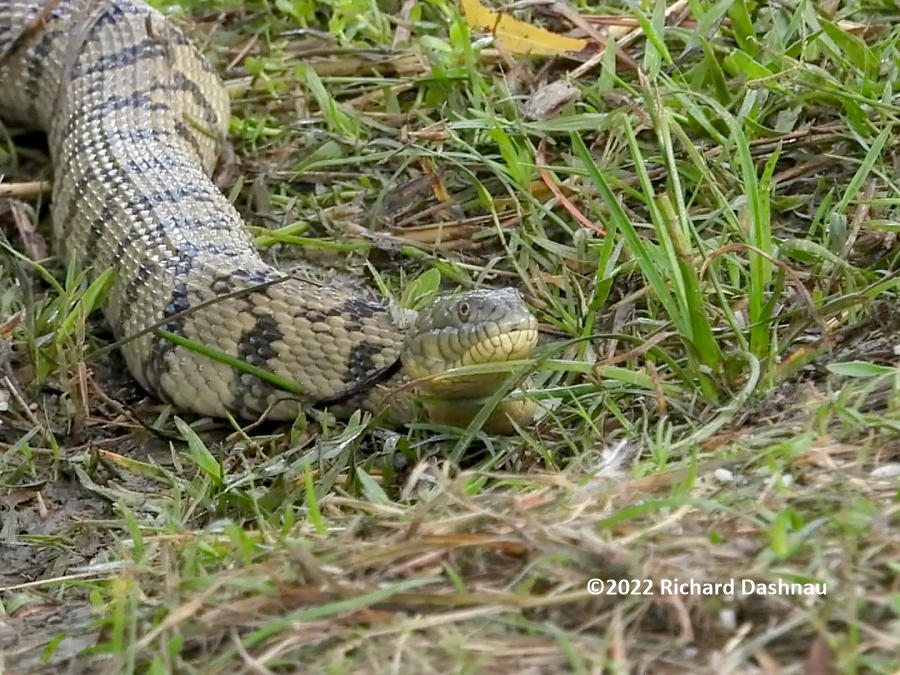
I spoke to
the fisherman and discovered he was fishing for Tilapia.
Tilapia are invasive in Texas waters, and can be legally taken
in various ways, including
cast
nets. I spoke with the fisherman while he cast his net, and a
snake seemed to approach after he'd thrown and retrieved the
net a few times (it might have been the same snake, but it
could
have been another). This surprised me, because the net
casting operation causes some disturbance--there's the
distinct "choof" of the multiple weights hitting the water,
and any
disturbance
while
retrieving the net. But, I wondered it at least one
snake had learned to associate those sounds with the extra
supply of fish; and so approached the disturbance.
I might
have been proved correct, because in the second or third cast
from the same spot the fisherman pulled out--a water
snake. I helped him and we easily released the
snake...which I
didn't
see again. I left the park soon after.
I
returned to the park on 09/03/22, and saw a
different person--also cast net fishing for Tilapia, and
therefore discarding the smaller bait fish. I started looking
for snakes, and told the
fisherman's family what
I
was looking for. I started watching snakes--2, maybe
three, moving around the banks, and apparently hunting. On
that day, the water had gotten high enough to
submerge the low bridge,
so
I couldn't get to the other side of the channel. The
snakes were certainly searching for prey near us. If we stood
still, they'd climb ashore just a few yards away,
search, and then return
to the water. I'd told the family that the snakes were there
for the fish, but I didn't think they believed me...at
first. I noticed a much larger fish, at least 5 inches
long.
(the small ones had been
2-3
inches long). The fish was moving through the water,
vertically, backwards, with its tail up. The fish was dead,
and since it was so large, I thought a turtle had it.
But it was being carried
by
a Diamondback Water Snake! The snake tried to swallow the
fish, but eventually gave up and spit it out. I shot video and
pictures. I think the fish was a Gizzard
Shad (Dorsoma cepedianum).
Judging
by the general condition of the carcass, I believe the fish
had been dead for a while before the snake grabbed it.
The snake might have been
induced to grab the carcass
because
it had already been searching for fish that were trapped on or
near the bank. Whatever the reason (the snake never told me),
it was a surprising experience.
To repeat, I've edited clips from
both days into this file.















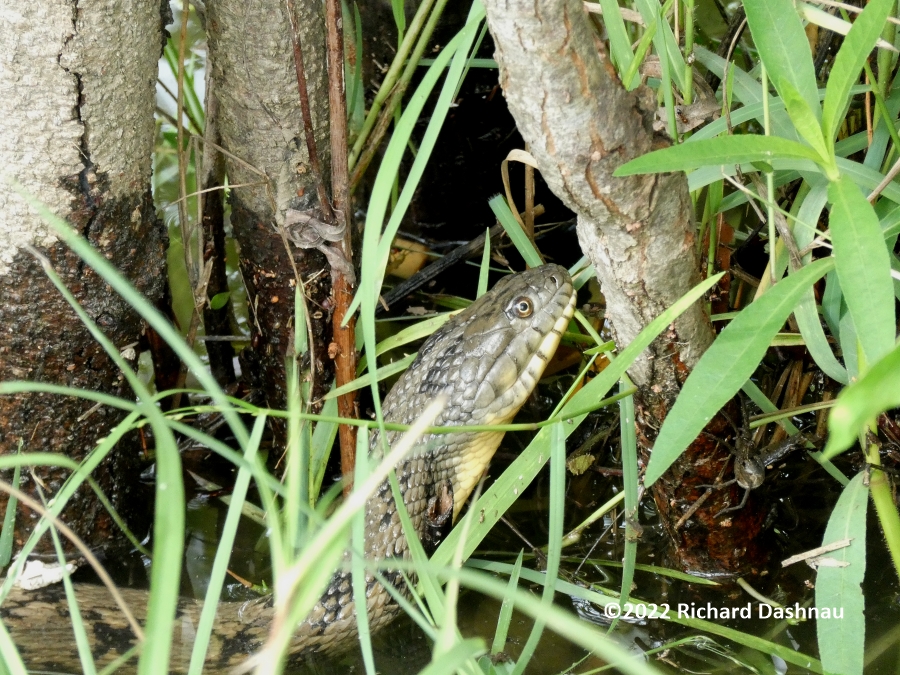

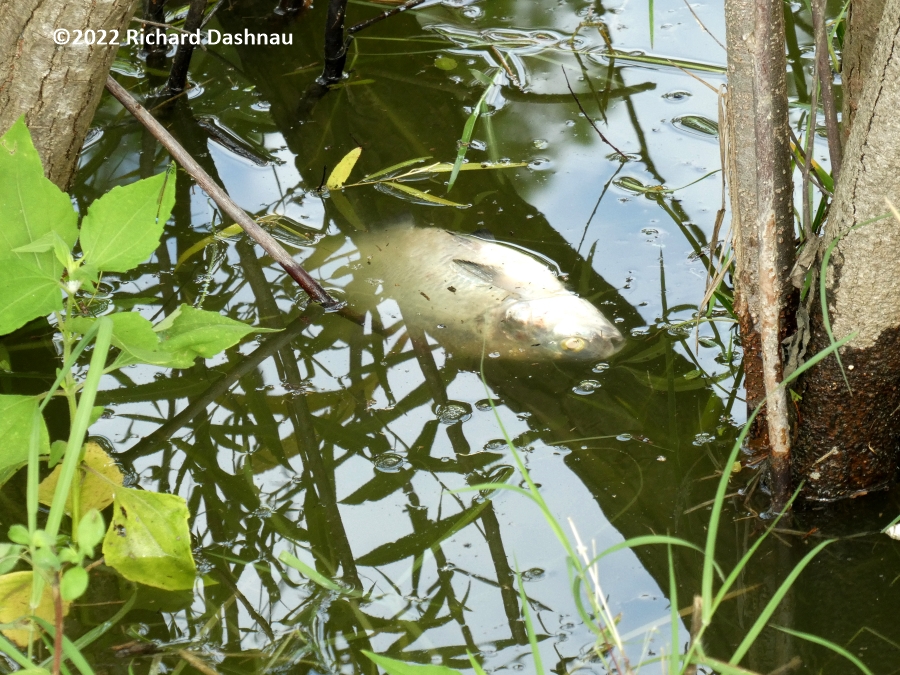
Snakes page 1 nonvenomous 2001 -2002 Snakes page 6 Rat Snakes 2002 - 2021
Snakes page 2 nonvenomous
2003 -2004 Snakes
page 7 venomous 2002 -2021
Snakes page 3 nonvenomous
2004 -2006
Snakes page 4 nonvenomous 2006
-2021
Go
back to my home page, Welcome to
rickubis.com
Go
back to the RICKUBISCAM
page.























































































































